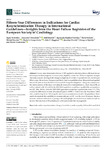Mostrar o rexistro simple do ítem
Fifteen-year differences in indications for cardiac resynchronization therapy in international guidelines—insights from the heart failure registries of the European Society of Cardiology
| dc.contributor.author | Tyminska, Agata | |
| dc.contributor.author | Ozieranski, Krzysztof | |
| dc.contributor.author | Brociek, Emil | |
| dc.contributor.author | Kaplon-Cieslicka, Agnieszka | |
| dc.contributor.author | Balsam, Pawel | |
| dc.contributor.author | Marchel, Michal | |
| dc.contributor.author | Crespo-Leiro, María Generosa | |
| dc.contributor.author | Maggioni, Aldo P. | |
| dc.contributor.author | Drozdz, Jaroslaw | |
| dc.contributor.author | Opolski, Grzegorz | |
| dc.contributor.author | Grabowski, Marcin | |
| dc.date.accessioned | 2023-02-17T10:33:27Z | |
| dc.date.available | 2023-02-17T10:33:27Z | |
| dc.date.issued | 2022-06-06 | |
| dc.identifier.citation | Tymińska A, Ozierański K, Brociek E, Kapłon-Cieślicka A, Balsam P, Marchel M, Crespo-Leiro MG, Maggioni AP, Drożdż J, Opolski G, Grabowski M. Fifteen-year differences in indications for cardiac resynchronization therapy in international guidelines—insights from the heart failure registries of the European Society of Cardiology. J Clin Med. 2022 Jun 6;11(11):3236. | es_ES |
| dc.identifier.issn | 2077-0383 | |
| dc.identifier.uri | http://hdl.handle.net/2183/32522 | |
| dc.description.abstract | [Abstract] Cardiac resynchronization therapy (CRT) applied to selected patients with heart failure (HF) improves their prognosis. In recent years, eligibility criteria for CRT have regularly changed. This study aimed to investigate the changes in eligibility of real-life HF patients for CRT over the past fifteen years. We reviewed European and North American guidelines from this period and applied them to HF patients from the ESC-HF Pilot and ESC-Long-Term Registries. Taking into consideration the criteria assessed in this study (including all classes of recommendations i.e., class I, IIa and IIb, as well as patients with AF and SR), the 2013 (ESC) guidelines would have qualified the most patients for CRT (266, 18.3%), while the 2015 (ESC) guidelines would have qualified the least (115, 7.9%; p-value for differences between all analyzed papers <0.0001). There were only 26 patients (1.8%) who would be eligible for CRT using the class I recommendations across all of the guidelines. These results demonstrate the variability in recommendations for CRT over the years. Moreover, this data indicates underuse of this form of pacing in HF and highlights the need for more studies in order to improve the outcomes of HF patients and further personalize their management. | es_ES |
| dc.language.iso | eng | es_ES |
| dc.publisher | MDPI | es_ES |
| dc.relation.uri | https://doi.org/10.3390/jcm11113236 | es_ES |
| dc.rights | Atribución 3.0 España | es_ES |
| dc.rights.uri | http://creativecommons.org/licenses/by/3.0/es/ | * |
| dc.subject | Cardiac resynchronization therapy | es_ES |
| dc.subject | Cardiomyopathy | es_ES |
| dc.subject | Heart failure | es_ES |
| dc.subject | Left bundle branch block | es_ES |
| dc.title | Fifteen-year differences in indications for cardiac resynchronization therapy in international guidelines—insights from the heart failure registries of the European Society of Cardiology | es_ES |
| dc.type | info:eu-repo/semantics/article | es_ES |
| dc.rights.access | info:eu-repo/semantics/openAccess | es_ES |
| UDC.journalTitle | Journal of Clinical Medicine | es_ES |
| UDC.volume | 11 | es_ES |
| UDC.issue | 11 | es_ES |
| UDC.startPage | 3236 | es_ES |
Ficheiros no ítem
Este ítem aparece na(s) seguinte(s) colección(s)
-
INIBIC-ICATC - Artigos [174]






